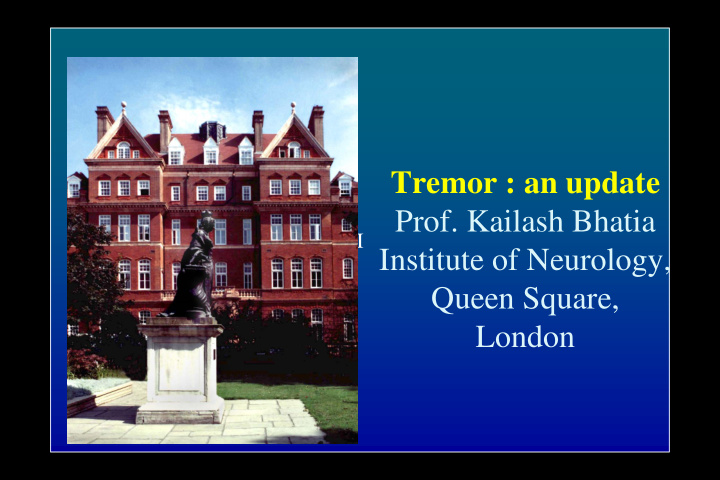



Tremor : an update Prof. Kailash Bhatia I Institute of Neurology, Queen Square, London
MDJ- 2018
MDS Consensus Criteria for ET (Deuschl et al.1998) • Inclusion: Bilateral, largely symmetrical postural or kinetic tremor involving hands and forearms that is visible and persistent Additional (or isolated ! ) tremor of the head may occur but without abnormal posturing
MDS Consensus Criteria for ET • Exclusion criteria include: Other signs, especially dystonia Isolated position -specific or task -specific tremor
ET has been considered as a pure or monosymptomatic disorder but….
ET literature (and dystonia) • Database of 350 pts with “ET” • 47% of patients had associated dystonia (Spasmodic Torticollis in 27%, Writers Cramp in 14%, blepharospasm 7%, Spasmodic Dysphonia 4%) 20% developed parkinsonism (after ET) • ‘‘This analysis finds no support for differentiation of ET subtypes and it suggests that ET, although heterogenous in its clinical presentation, is a single disease e ntity.” Lou & Jankovic,
Other features reported for ET • Cerebellar dysfunction • Cognitive changes- Duane et al , 2002, Higginson et al, 2008);- not controlled for depression, anxiety, co- morbidities, medications, etc • Olfaction: affected -Louis et al 2002 – however not found in other studies (Shah et al); may be related to co- morbidities or specific subgroup • Hearing loss: Ondo et al, -but age dependent rather then tremor severity dependent, age related?
Misdiagnosis of ET
What conditions are commonly mistaken for ET and vice versa? • Enhanced physiological tremor • Tremulous dystonia or dystonic tremor • PD, especially “BTP” • Misdiagnosis rate of ET in 2 studies 37% (Jain et al, 2007) and 50% (Schrag et al, 2000)
Dystonia in ET was reported in between 7- 47% in various studies
The definition of tremor has not changed • An involuntary, rhythmic, oscillatory movement of a body part • Problem: the only perfectly rhythmic tremor is primary orthostatic tremor How rhythmic must an oscillation be?
The concept of “isolated” and “combined” tremor
Examples of Axis 1 classification Essential tremor Task-specific Isolated tremor tremor syndromes Primary orthostatic tremor Dystonic tremor Rest tremor Combined tremor Bradykinesia syndromes Rigidity Tremor with ataxia
ET is a syndrome with multiple etiologies. • There is genetic heterogeneity. • Many cases appear to be sporadic. • It is an early phenotype of hereditary dystonia (eg, ANO3), hereditary ataxia (eg, SCA12), and Parkinson disease. Louis. Arch Neurol 2009; 66: 1202-8 Deuschl et al. Mov Disord 2015; 30: 1327-34 Choudhury et al. Mov Disord Clin Pract 2018; 5: 39-46 Stamelou et al. Mov Disord 2014; 29: 928-934
ET plus “soft signs” 1. Rest tremor or questionable rest tremor 2. Impaired tandem gait 3. Questionable dystonic posturing of the hands, head, etc. Strongly 4. Memory impairment discouraged. 5. Mild sensory neuropathy 6. Markedly asymmetric upper limb tremor 7. Jerky tremor
Tremor Investigation Group (TRIG) 1990 Validity of subtle (soft) signs of dystonia? Courtesy Roger Elble
ET plus is more common than ET? Cohort of patients with lower limb tremor Rajalingam et al. Parkinsonism Relat Disord 2018; 56: 109-110
A 69 year old man with a 10 year history of worsening tremor – possible family history in mother late in her life – mild benefit with alcohol
Clinical example Axis 1 classifications may change. Dystonic Indeterminate tremor tremor ET ET plus syndrome Increased Isolated Action tremor Increased tremor bilateral upper 1 yr 2 yr 3 yr in the head, tremor Axis Strained voice extremity voice and Strained voice Cervical 1 tremor for 1 upper limbs Slight head tilt dystonia yr. Antecedent Strong Fam. Antecedent ET Hx ET 1 yr 3 yr 2 yr Idiopathic Idiopathic Idiopathic ANO3 Axis Familial Familial Familial mutation 2 ANO3 dystonia Stamelou et al. Mov Disord 2014; 29: 928-934.
Clinical syndrome – Possible Essential tremor – but genetic diagnosis DYT2 (HPCA gene mutations)
Axis 1 subtypes – more etiologic specificity? Data from one subtype may not be generalizable to other subtypes
Management of Essential tremor syndromes Drugs : Functional neurosurgery: • Propranolol - VIM DBS • Primidone - Thalamic lesioning • Topirimate - Focussed ultrasound Botulinum toxin injections:
NEJM 2016
Orthostatic tremor- may be difficult to visualise as very fast – but you could listen to it!
Rubral tremor
70 year old with a 25 year history of postural tremor and more recent gait disorder, cognitive problems, MRI shows some cerebellar atrophy
MDJ 2020 in press
Concluding remarks • New classification will help with : • Effect of drugs such as propranolol, primidone and others in different tremor syndromes • And whether different targets should be considered for DBS in ET syndrome versus DT syndrome for example • What about anticholinergics in ET plus with dystonia? • Outcomes and prognosis may differ
Recommend
More recommend